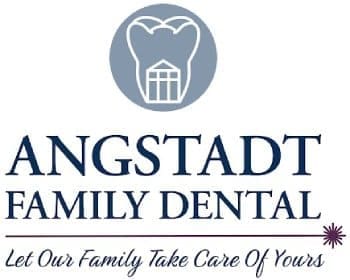
Sleep apnea, a condition that disrupts breathing during sleep, often goes undiagnosed for years. Its symptoms are easy to overlook, frequently mistaken for stress, burnout, or just “poor sleep.” Yet what many patients don’t realize is that the first signs of sleep apnea may appear in the mouth, and during a routine dental exam, your dentist might be the first one to notice.
At Angstadt Family Dental, we believe in whole-person care. That means looking beyond just teeth and gums to identify patterns and symptoms that may point to broader health concerns. Sleep apnea is one of those silent conditions that can have a profound impact on your health, and dentistry is uniquely positioned to catch it early.
What Is Sleep Apnea and Why Should You Care?
Sleep apnea, particularly obstructive sleep apnea (OSA), occurs when the airway becomes partially or completely blocked during sleep. These blockages cause breathing to pause repeatedly throughout the night, sometimes hundreds of times. Each pause disrupts your sleep cycle and deprives your body of oxygen, putting strain on the heart, brain, and other vital systems.
Over time, untreated sleep apnea can lead to a host of serious health issues, including high blood pressure, cardiovascular disease, type 2 diabetes, mood disorders, and memory problems. Even beyond these medical risks, the quality-of-life impact is substantial. People with sleep apnea often experience chronic fatigue, irritability, brain fog, and poor concentration, making daily functioning more difficult than it needs to be.
The Oral Clues Your Dentist May Notice First
Because the airway, jaw, and oral tissues are directly involved in the mechanics of breathing, dental professionals are often among the first to spot signs of a compromised airway. During routine exams, there are several subtle but telling clues we look for that may suggest an underlying sleep issue.
For instance, patients who grind their teeth, a condition known as bruxism, often do so in response to the body struggling for air during sleep. This grinding can wear down the teeth and create headaches or jaw pain, which patients sometimes don’t realize are connected to sleep problems. Similarly, a tongue that appears scalloped or rippled around the edges can indicate it’s pressing repeatedly against the teeth due to restricted airway space.
Another common indicator is dry mouth or chronic sore throat, both of which can stem from frequent mouth breathing at night, which is a common coping mechanism when nasal airflow is restricted. Enlarged tonsils, a swollen uvula, or a small, recessed jaw may also suggest a structural tendency toward airway obstruction. Even the shape of your palate or the way your jaw aligns can provide insight into how freely air is moving when you’re asleep.
When we see these patterns, especially in combination, it’s worth having a conversation. Asking questions about snoring, morning headaches, or daytime tiredness isn’t just idle curiosity — it’s part of a broader commitment to your overall wellness.
How Dentistry Fits Into Diagnosis and Treatment
Although dentists can’t formally diagnose sleep apnea, we can play a crucial role in screening and referral. If we suspect that a patient might be experiencing symptoms related to OSA, we may recommend a sleep evaluation, either through your physician or a board-certified sleep specialist. These evaluations often involve an at-home sleep test or an overnight study in a sleep lab, which can confirm the presence and severity of apnea episodes.
Once diagnosed, treatment options vary depending on the severity of the condition. In more severe cases, a CPAP machine may be recommended to maintain continuous airflow during sleep. But for many patients with mild to moderate sleep apnea, a custom-fitted oral appliance is an effective alternative, and that’s where dental expertise comes back into play.
What Is an Oral Appliance and How Can It Help?
Oral appliances for sleep apnea are small, custom-designed devices that look a bit like a mouthguard or retainer. Worn during sleep, they work by gently repositioning the lower jaw forward, helping to keep the airway open. This forward positioning prevents the soft tissues of the throat from collapsing and blocking airflow.
These devices are quiet, portable, and easy to care for, making them a welcome option for patients who can’t tolerate a CPAP machine or want a more travel-friendly solution. Many patients report feeling more rested, alert, and energetic within just a few nights of using an oral appliance consistently.
We work closely with sleep physicians to ensure that the appliance is tailored to your anatomy and sleep study results. It’s not a one-size-fits-all approach — and it shouldn’t be. Proper calibration and follow-up are essential to achieving the best results.
When to Speak Up About Sleep Issues
Suppose you’ve been experiencing persistent fatigue, morning headaches, snoring, or even unexplained jaw pain. In that case, it’s worth bringing these symptoms to your dentist’s attention, even if they don’t seem related to oral health at first glance. Often, patients assume these issues are just part of getting older or working long hours, but that’s not always the case.
And if your partner has mentioned that you snore loudly, gasp for air, or stop breathing during the night, don’t brush it off. These are red flags worth investigating. Your next dental visit could be more than just a cleaning. It could be the beginning of a solution to a serious health concern that’s been hiding in plain sight.
Better Sleep Could Begin With a Better Dental Exam
At Angstadt Family Dental, we recognize that your oral health is just one part of the overall picture. That’s why we look deeper. Sleep apnea may not seem like a dental issue on the surface, but the signs are there if you know where to look.
Whether you’ve noticed symptoms yourself or just want peace of mind, we encourage you to start the conversation with us. Better sleep, better health, and better quality of life might begin with something as simple as opening your mouth—and letting your dentist take a closer look.

Leave a Reply